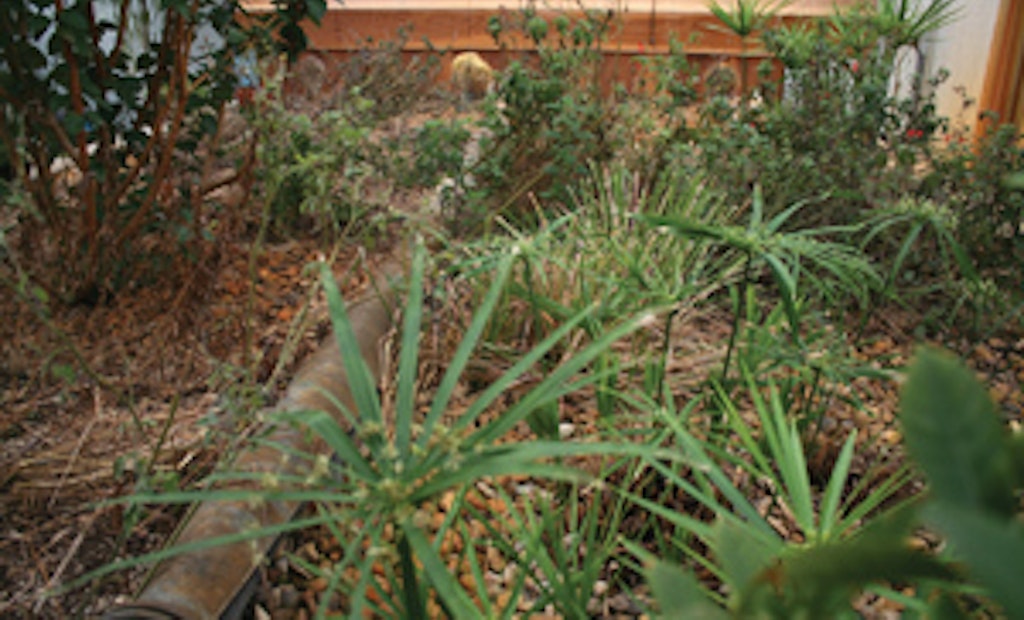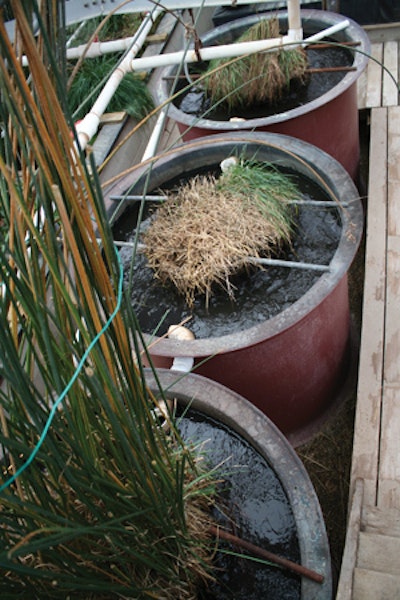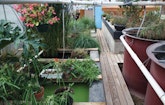
Interested in Repair?
Get Repair articles, news and videos right in your inbox! Sign up now.
Repair + Get AlertsThree solar tanks, a lagoon, and a marsh inside a 28- by 48-foot greenhouse treat wastewater from 50 people in an office building, private studio, and family residence in Albany, Ind. The natural purifying process takes one to two weeks, eliminates sludge, and produces effluent that meets and exceeds permit parameters.
Designed by John Todd at Ocean Arcs International, Woods Hole, Mass., and upgraded by Erin Wilson, Class 4 operator at the Muncie Wastewater Facility, the Solar Aquatics System is licensed by the state as a wastewater treatment plant. The state also mandated that Todd design it with far more capacity (1,750 gpd) than was needed for treatment. Class 1 operator Bill Duell runs the facility.
Over-engineered
Wastewater gravity-flows through 4-inch PVC laterals to a lift station with two alternating Zoeller grinder pumps that send liquid 250 feet to a 3,200-gallon circular concrete equalization vault. All plumbing is 1.5-inch PVC pipe.
The vault has a welded aluminum lid with trap doors, a convex bottom, 20 feet of hydraulic head, and two Series 151 Zoeller solids-handling pumps. “They were too large for our needs, but I couldn’t find anything smaller,” says Duell.
The pumps in the vault alternate 15 minutes on and off, sending 29 gpm 10 feet to a distribution box in the greenhouse. The box, made of translucent plastic and holding 78 gallons, allows sunlight to penetrate and begin treating the water.
The influx is too much for the less than 1 gpm flows through the system, so Wilson designed a weir and flume for the distribution box. Water swirls around for 2.5 minutes; then half of it enters the system and the rest returns to the equalization vault.
The system is aerated by a blower cycling 21 minutes on and 24 minutes off. When it activates, a 9-inch fine-bubble diffuser in the distribution box agitates the wastewater into a homogenized mixture, while the recirculation loop continues to expose it to sunlight and air.
A grow lamp hanging over the distribution box burns continually. “It really does affect treatment,” says Duell. “In summer, the loop treats so much ammonia that effluent numbers are almost below my permit levels.”
Sunny and warm
Leaving the distribution box, liquid flows to the first of three 650-gallon vertical circular solar tanks set in series. The custom-made, double-walled 450-pound fiberglass tanks each have a 9-inch fine-bubble diffuser supplying air at 2 psi. The retention time per tank is two days.
Two tanks have a clump of native marsh grass suspended on two rods over the liquid, and one has bulrushes. The long roots function as habitat for bacteria that consume the nutrients, while the plants remove some ammonia.
Liquid gravity-flows through the solar tanks, then travels 30 feet to a 50-gallon radial flow separator that removes most solids. The unit is from the aquaculture industry.
When sludge builds up in the separator, Duell drains most of the liquid back to the equalization vault before scooping out the solids. He lines 10-inch fabric aquatic plant containers with fiberglass window screening and newspaper, then dewaters the solids in them.
When the material reaches the proper consistency, he rubs it through a 1/4-inch mesh screen to form pellets. After they bake dry on a bench covered with black plastic to absorb more solar heat, Duell composts them for use as fertilizer.
More vegetation
From the separator, liquid flows 30 feet to the front of a 30- by 7- by 3.5-foot-deep tank. Water enters this 5,000-gallon “lagoon” by spilling into a vertical 24-inch perforated drain tile with a basket of Bio-Balls (multi-faceted media that provide a large surface to grow ammonia-neutralizing bacteria). “It’s also a quiet chamber that traps the last remaining solids,” says Duell.
Besides sunlight hitting the lagoon, staggered floating boxes with native plants Duell harvested from creeks and ponds continue the treatment cycle. At the rear of the lagoon, a standpipe pulls water into a 30-foot pipe plumbed to the front of a 15- by 7- by 3.5-foot-deep tank with stone and plants, mimicking a marsh environment. This provides final polish for denitrification and eliminates pathogens.
After entering a UV light tube, liquid passes through a flowmeter and drops into a 100-gallon animal water trough with two 9-inch fine-bubble diffusers. When the blower activates, the aerators raise the dissolved oxygen level to 8 or 9 mg/L. When the blower shuts off, the supercharged liquid maintains incoming oxygen-depleted water at 7.5 mg/L, or 1.5 mg/L above the plant’s permit number.
Water discharges into a slotted 12-inch county drain tile. “At our flows, we probably have total absorption within 200 feet, and the liquid never reaches Campbell Creek 1.5 miles away,” says Duell.







